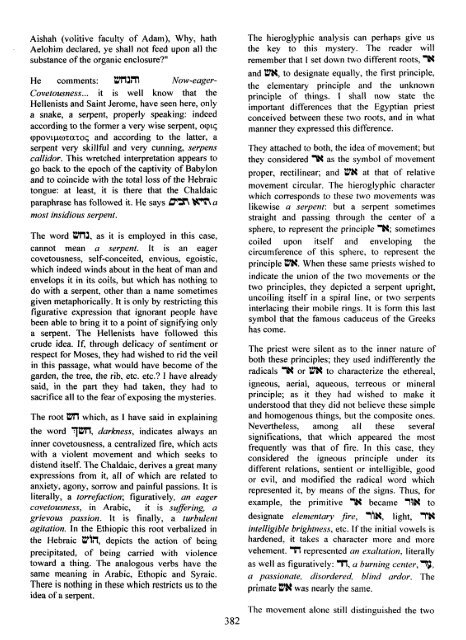Gematria - Sepher Sapphires Volume 1.pdf
Gematria - Sepher Sapphires Volume 1.pdf
Gematria - Sepher Sapphires Volume 1.pdf
You also want an ePaper? Increase the reach of your titles
YUMPU automatically turns print PDFs into web optimized ePapers that Google loves.
Aishah (volitive faculty of Adam), Why, hath<br />
Aelohim declared, ye shall not feed upon all the<br />
substance of the organic enclosure?"<br />
He comments: 1W13R Now-eager-<br />
Covetousness ... it is well know that the<br />
Hellenists and Saint Jerome, have seen here, only<br />
a snake, a serpent, properly speaking: indeed<br />
according to the former a very wise serpent, ocpy<br />
cppovtpw.sa.coq and according to the latter, a<br />
serpent very skillful and very cunning, serpens<br />
callidor. This wretched interpretation appears to<br />
go back to the epoch of the captivity of Babylon<br />
and to coincide with the total loss of the Hebraic<br />
tongue: at least, it is there that the Chaldaic<br />
paraphrase has followed it. He says &% Km a<br />
most insidious serpent.<br />
The word m3, as it is employed in this case,<br />
cannot mean a serpent. It is an eager<br />
covetousness, self-conceited, envious, egoistic,<br />
which indeed winds about in the heat of man and<br />
envelops it in its coils, but which has nothing to<br />
do with a serpent, other than a name sometimes<br />
given metaphorically. It is only by restricting this<br />
figurative expression that ignorant people have<br />
been able to bring it to a point of signifLing only<br />
a serpent. The Hellenists have followed this<br />
crude idea. If, through delicacy of sentiment or<br />
respect for Moses, they had wished to rid the veil<br />
in this passage, what would have become of the<br />
garden, the tree, the rib, etc. etc.? I have already<br />
said, in the part they had taken, they had to<br />
sacrifice all to the fear of exposing the mysteries.<br />
The root Wll which, as I have said in explaining<br />
the word TBTl, darkness, indicates always an<br />
inner covetousness, a centralized fire, which acts<br />
with a violent movement and which seeks to<br />
distend itself. The Chaldaic, derives a great many<br />
expressions from it, all of which are related to<br />
anxiety, agony, sorrow and painful passions. It is<br />
literally, a torrefaction; figuratively, an eager<br />
covetousness, in Arabic, it is suflering, a<br />
grievous passion. It is finally, a turbulent<br />
agitation. In the Ethiopic this root verbalized in<br />
the Hebraic Wic'l, depicts the action of being<br />
precipitated, of being carried with violence<br />
toward a thing. The analogous verbs have the<br />
same meaning in Arabic, Ethopic and Syraic.<br />
There is nothing in these which restricts us to the<br />
idea of a serpent.<br />
The hieroglyphic analysis can perhaps give us<br />
the key to this mystery. The reader will<br />
remember that I set down two different roots, %<br />
and IVN, to designate equally, the first principle,<br />
the elementary principle and the unknown<br />
principle of things. I shall now state the<br />
important differences that the Egyptian priest<br />
conceived between these two roots, and in what<br />
manner they expressed this difference.<br />
They attached to both, the idea of movement; but<br />
they considered % as the symbol of movement<br />
proper, rectilinear; and WN at that of relative<br />
movement circular. The hieroglyphic character<br />
which corresponds to these two movements was<br />
likewise a serpent: but a serpent sometimes<br />
straight and passing through the center of a<br />
sphere, to represent the principle %; sometimes<br />
coiled upon itself and enveloping the<br />
circumference of this sphere, to represent the<br />
principle m. When these same priests wished to<br />
indicate the union of the two movements or the<br />
two principles, they depicted a serpent upright,<br />
uncoiling itself in a spiral line, or two serpents<br />
interlacing their mobile rings. It is form this last<br />
symbol that the famous caduceus of the Greeks<br />
has come.<br />
The priest were silent as to the inner nature of<br />
both these principles; they used indifferently the<br />
radicals % or VN to characterize the ethereal,<br />
igneous, aerial, aqueous, terreous or mineral<br />
principle; as it they had wished to make it<br />
understood that they did not believe these simple<br />
and homogenous things, but the composite ones.<br />
Nevertheless, among all these several<br />
significations, that which appeared the most<br />
frequently was that of fire. In this case, they<br />
considered the igneous principle under its<br />
different relations, sentient or intelligible, good<br />
or evil, and modified the radical word which<br />
represented it, by means of the signs. Thus, for<br />
example, the primitive '1N became 13N to<br />
designate elementary )re, %, light, TN<br />
intelligible brightness, etc. If the initial vowels is<br />
hardened, it takes a character more and more<br />
vehement. TI represented an exaltation, literally<br />
as well as figuratively: Ti, a burning center, '20,<br />
a passionate, disordered, blind ardor. The<br />
primate WN was nearly the same.<br />
The movement alone still distinguished the two


